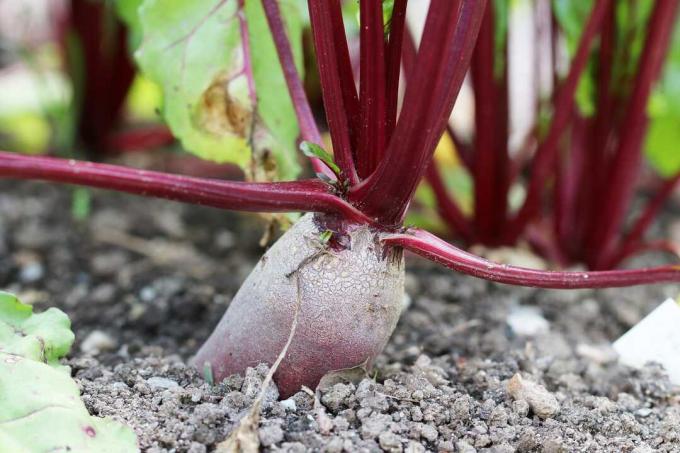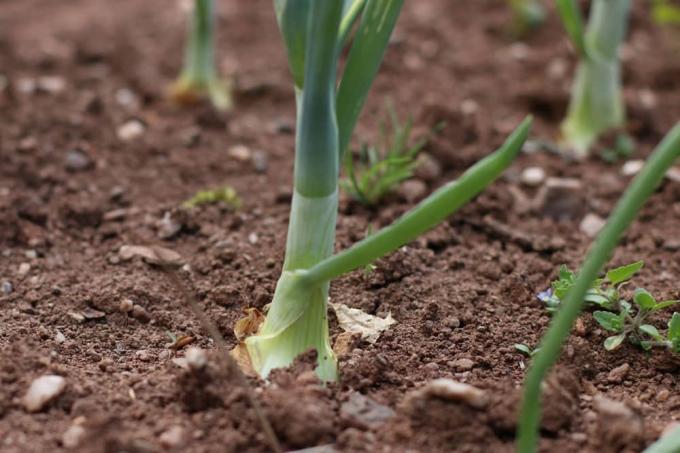

Table of contents
- Sow the beetroot
- The varieties of beetroot
- pests and diseases
- The harvest of the fruit and the storage and preservation
- Interesting facts about beetroot
- The care of the plants
- Sowing and care at a glance
- harvest
- Use & Storage
Beetroot is often grown in the garden because it does not have high demands on the soil and exposure to light. However, the soil on which the beetroot is grown should not be too nitrogenous, as this plant then accumulates too much nitrite, similar to chard or spinach. The beetroot should not be sown too early, as they will develop shoots if they get frost during the growth phase. The shoots are not desired on this plant. Therefore, sowing should not be done until April. If you want to be on the safe side here, wait for the ice saints. Should frost occur again, the beetroot can be protected with a thin fleece. Beets are great for storage. Therefore, the main cultivation should take place in June. The ripe fruits can be harvested and stored from October. Storage takes place in boxes containing straw, sand or peat. In this way, the tubers are stored protected from light and cold. If the harvest takes place earlier, the fruits can also be boiled and thus preserved.
Sow the beetroot
Before sowing, the soil should be hoed and compost incorporated. Sow outdoors in April or May at a distance of about 10 centimeters within the individual rows. The rows should be about 25 centimeters apart. The sowing depth should be two to three centimetres. After sowing, another layer of compost should be applied, but no manure. It is important to water the plants regularly after sowing. If the plant is to be pre-cultivated, it can be sown as early as March in a manure bed. The sprouts can then be planted in the garden in April. To support the growth of the plants, rock flour can be hooked into the soil. Regular application of compost can also help the plant grow, as can chopping and watering.
The varieties of beetroot
Many people know beetroot as the well-known dark red root, which divides minds due to its earthy taste. However, there are different variations of varieties. In addition to the round variety, there are also those that have flattened roots, as well as beetroot that have cylindrical roots or pointed roots. The white and yellow beets stand out from this, which taste mild and sweeter, not quite as earthy. One of the well-known varieties is the Formanova, which has a cylindrical shape. The Forono also has a cylindrical shape and is also very productive, which makes it very attractive for cultivation in the home garden. The Tonda di Chioggia is a ringed variety that is red and white in color. Eaten raw, it is very sweet and tender. When this variety is cooked, the red and white stripes merge. The Egyptian Flat Round is an old variety that has deep red leaves, an aromatic flavor and grows very quickly. Burpee's Golden is a beetroot that is orange on the outside and yellowish on the inside. These fruits taste very aromatic and sweet. The red ball is a very common grower as it is an uncomplicated, round strain that is very aromatic. The Albina Veredura is a white beet that has a sweet taste and is often used in the preparation of raw vegetable salads. This variety can only be sown in June as it tends to bolt.
pests and diseases
Beets are robust plants that are rarely attacked by pests or diseases. A well-known pest of this plant is the beet fly. The beets can also be damaged by aphids or flea beetles. Furthermore, nematodes or beet nodules can wreak havoc on this plant. In addition, various types of beetles such as the tortoiseshell beetle, the turnip scavenger beetle, the turnip weevil or the tortoiseshell beetle can cause damage to the fruit. In addition to the pests that can attack beetroot, there are also diseases such as heart and dry rot, root blight, yellowing disease or the Cercospora leaf spot.
The harvest of the fruit and the storage and preservation
As with many other plants, the fruits of the plant last longest if left in the bed. The prerequisite, however, is that no frost sets in. The beetroot can withstand temperatures down to minus three degrees, but they should be harvested at lower temperatures. If the temperatures are higher, the plants can be harvested fresh just before consumption. If there is a threat of frost, the plants should be carefully pulled out of the ground. In order to be able to store the fruits, they must not be injured. This is the only way that germs cannot penetrate and multiply there during the storage period. Before the fruit can be stored, the leaves must be removed. To do this, they are carefully twisted off. The roots can now be stored in the refrigerator for some time. If the tubers are to be stored for a long period of time, it is advisable to store them in the cellar. Boxes in which there is moist sand are particularly suitable for storing beetroot. The tubers must not be washed before storage. The remaining soil on the fruit protects it from mold and other germs or bacteria. Stored well, they will last well into spring. In addition, the beetroot can also be fermented with lactic acid or boiled down.
Interesting facts about beetroot
Beetroot requires well-drained, humus-rich, nutrient-rich soil. Sufficient soil moisture should be ensured. Since the small turnips have relatively deep roots, the soil should be deep and not too acidic. pH values between 6.5 and 7.8 are ideal. As a fertilizer, a fertilizer containing chloride is preferred. The best time for sowing is May and June. If you want to harvest early, you can start growing in pots as early as April and plant the young plants in the garden in May. In general, however, beets thrive best when sown directly outdoors. Their seeds are placed in grooves two to three centimeters deep and covered with soil. After that, the beds must be kept slightly moist. At a temperature between 15° and 20°C the seeds will germinate within two to three weeks.
If you want to harvest small beets, you can simply sow more densely. For larger beets, either pay attention to a larger distance when sowing (seed bands) or stretch the young plants to a distance of about 15x5cm. The harvest time is around October-November, but you can also harvest the smaller beets at any time. Grows very well in places where legumes or kohlrabi were previously grown.
Best neighbors are borage, zucchini, onions, cumin, parsnips, lettuce. Also ideal for mixed cultivation with dill and savory. The taste also improves in mixed cultivation. However, unfavorable neighbors are leeks, tarragon, potatoes, chard, parsley, tomatoes, spinach, chives.
The care of the plants
In order for beautiful tubers to form, the beetroot need sufficient water during their growth. If the tubers are sticking out of the ground, it makes sense to pile up some soil around the stem so that they are completely covered again. Furthermore, the regular removal of weeds and the hoeing of the beds ensures that the plants thrive.
Sowing and care at a glance
- grow in pots from April or sow outdoors from May
- Sowing depth: 2-3 centimeters
- Germination temperature 15-20°C, germination time 2-3 weeks
- ensure good watering
- Pulling weeds and hoeing beds
- possibly pile up soil on the tubers
harvest
These should also not be grown as a pre-crop if you want to grow beetroot in this spot afterwards. When harvesting, it is best to use trick 17. In the morning, lift the beets slightly with a fork without tearing off the roots, and pull the beets out of the ground in the afternoon. In this way, the nitrate content drops significantly. The fact that beetroot is so healthy is due to the vitamins A, B1, B2, C, as well as folic acid, the antibiotic betaine, Betalains, Flavonoids, Carbohydrates, Phosphorus, Potassium, Magnesium, Iron, Calcium, Sodium, Copper, Manganese, Zinc. All this is contained in the small beets. The red dye is very colourfast, so it is best to ensure that tablecloths and clothing do not come into contact with it. The red color is difficult to remove even with hands.
Use & Storage
Of course, beetroot tastes best right after harvest. But they can also be stored quite well in a so-called ground or cellar heap. Here they are placed in light-colored sand and remain fresh for months. This was a way of stocking up for the winter before most homes had fridges and freezers. Many other types of vegetables are also suitable for this form of storage, such as carrots or the many different types of cabbage.
 garden editorial
garden editorial I write about everything that interests me in my garden.
Learn more about types of vegetables

Planting asparagus: 9 tips for growing asparagus
Asparagus can be grown in the garden or raised bed with a little knowledge of growth. In addition to the right choice of location, the preparatory and maintenance measures are of great importance. If you want to grow white or green asparagus, the procedure is slightly different.

Can you eat beetroot raw!? Healthy or dangerous?
Beets are tasty and healthy. As a rule, however, they will only be eaten cooked. But could you eat them raw? Yes, you could, beetroots are not poisonous. However, there are some disadvantages associated with it. More about this here.

Grow Peanut Plant | 10 tips for growing peanuts yourself
Peanuts are a popular snack. Whether in muesli, as a small snack between meals or as an ingredient in hearty dishes. They are tasty and, if consumed in moderation, bring health benefits. How good that you can draw them yourself.

Old Fruits & Vegetables | 26 historical & forgotten varieties
Among the historical varieties there are vegetables and fruits with an incomparable variety of tastes. Nevertheless, numerous varieties have disappeared or been forgotten. Lovers of old varieties make it possible for the precious treasures to be brought back into the focus of self-sufficient gardens.

Growing onions, sweet onions - sowing, planting and care
Onions can be cultivated in three different ways: you can plant onions, bring onions outdoors as direct sowing, and onions can be brought forward and then planted or cultivated. put. More and more people are now planting their own bulbs in the garden. For beginners, this may all sound a bit complicated. It's not difficult though. Practice makes perfect and the great sense of achievement comes at the latest with the harvest.

Growing radishes: sowing the plants, caring for them, harvesting + storing
Crunchy radishes taste deliciously aromatic with a touch of spiciness. You can easily grow the tubers yourself, in the garden or on the balcony. Here you will find everything you need to know and tips for cultivation. The harvest will be a complete success.
